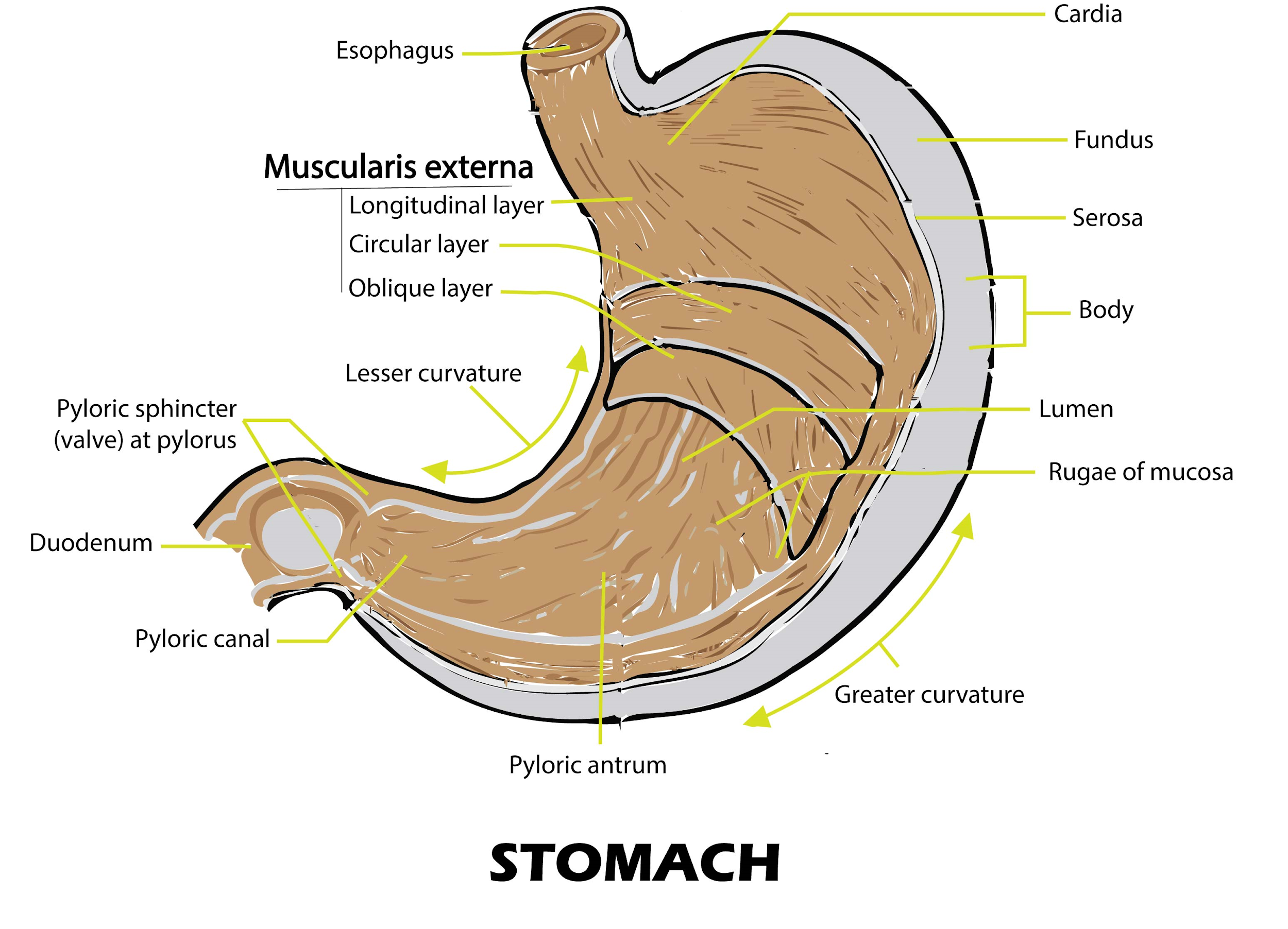
How is the shape of the stomach?
(a) As V
(b) As J
(c) As O
(d) None of the above
Answer
553.8k+ views
Hint: The shape of the stomach is similar to the letter that comes between the letters I and K. The exact position of the stomach in the alimentary canal is between the esophagus and the duodenum, which is the first part of the small intestine.
Complete answer:
The shape of the stomach is as J. It is a muscular hollow organ in the gastrointestinal tract located in the left part of the abdominal cavity, just inferior to the diaphragm of humans and many other animals including several invertebrates. The stomach is a roughly crescent-shaped enlargement of the gastrointestinal tract, located between the esophagus and the duodenum.
Additional Information:
- The stomach functions as a vital digestive organ in the digestive system. The stomach comes into action when chewing food enters the stomach through the esophagus.
- In the stomach, a chemical breakdown of food occurs through enzymes and hydrochloric acid.
- The stomach has two parts: fundus and pyloric. The dome- shaped fundus is located inferior to the diaphragm. Below the fundus is the main body of the stomach and the pyloric is funnel- shaped situated at the junction of the stomach and duodenum.

- The sphincters are bands of smooth muscles responsible for controlling the further movement of food.
- The pyloric sphincter is responsible for controlling the passage of partially digested food from the stomach into the duodenum where peristalsis occurs to move partially digested food through the rest of the intestines.
- Two sphincters keep the contents of the stomach contained; the lower esophageal sphincter that is found in the cardiac region, at the junction of the esophagus and stomach, and the pyloric sphincter is present at the junction of the stomach with the duodenum.
So, the correct answer is ‘J’.
Note:
- The stomach is located between the esophagus and the duodenum and it is also a roughly crescent-shaped enlargement of the gastrointestinal tract.
- The stomach has two parts: fundus and pyloric. The fundus is dome- shaped whereas the pyloric is funnel-shaped.
- A stomach can hold about one liter of food. The newborn human baby will only be able to retain about 30 milliliters of food in the stomach.
- The sphincters are bands of smooth muscles responsible for controlling the further movement of food.
Complete answer:
The shape of the stomach is as J. It is a muscular hollow organ in the gastrointestinal tract located in the left part of the abdominal cavity, just inferior to the diaphragm of humans and many other animals including several invertebrates. The stomach is a roughly crescent-shaped enlargement of the gastrointestinal tract, located between the esophagus and the duodenum.
Additional Information:
- The stomach functions as a vital digestive organ in the digestive system. The stomach comes into action when chewing food enters the stomach through the esophagus.
- In the stomach, a chemical breakdown of food occurs through enzymes and hydrochloric acid.
- The stomach has two parts: fundus and pyloric. The dome- shaped fundus is located inferior to the diaphragm. Below the fundus is the main body of the stomach and the pyloric is funnel- shaped situated at the junction of the stomach and duodenum.

- The sphincters are bands of smooth muscles responsible for controlling the further movement of food.
- The pyloric sphincter is responsible for controlling the passage of partially digested food from the stomach into the duodenum where peristalsis occurs to move partially digested food through the rest of the intestines.
- Two sphincters keep the contents of the stomach contained; the lower esophageal sphincter that is found in the cardiac region, at the junction of the esophagus and stomach, and the pyloric sphincter is present at the junction of the stomach with the duodenum.
So, the correct answer is ‘J’.
Note:
- The stomach is located between the esophagus and the duodenum and it is also a roughly crescent-shaped enlargement of the gastrointestinal tract.
- The stomach has two parts: fundus and pyloric. The fundus is dome- shaped whereas the pyloric is funnel-shaped.
- A stomach can hold about one liter of food. The newborn human baby will only be able to retain about 30 milliliters of food in the stomach.
- The sphincters are bands of smooth muscles responsible for controlling the further movement of food.
Recently Updated Pages
What is the correct Lewis structure for arsenic class 11 chemistry CBSE

On the basis of the following observations made with class 11 chemistry CBSE

What is the relation between optical density refractive class 11 physics CBSE

Three different coins are tossed together Find the class 11 maths CBSE

An object of specific gravity rho is hung from a massless class 11 physics CBSE

During an isothermal expansion of an ideal gas its class 11 chemistry CBSE

Trending doubts
What is meant by exothermic and endothermic reactions class 11 chemistry CBSE

10 examples of friction in our daily life

One Metric ton is equal to kg A 10000 B 1000 C 100 class 11 physics CBSE

1 Quintal is equal to a 110 kg b 10 kg c 100kg d 1000 class 11 physics CBSE

Difference Between Prokaryotic Cells and Eukaryotic Cells

What are Quantum numbers Explain the quantum number class 11 chemistry CBSE




